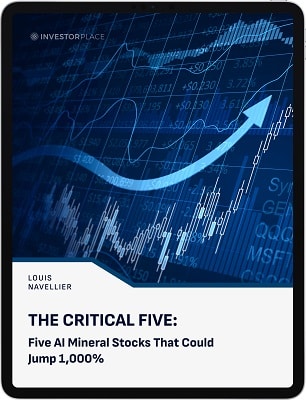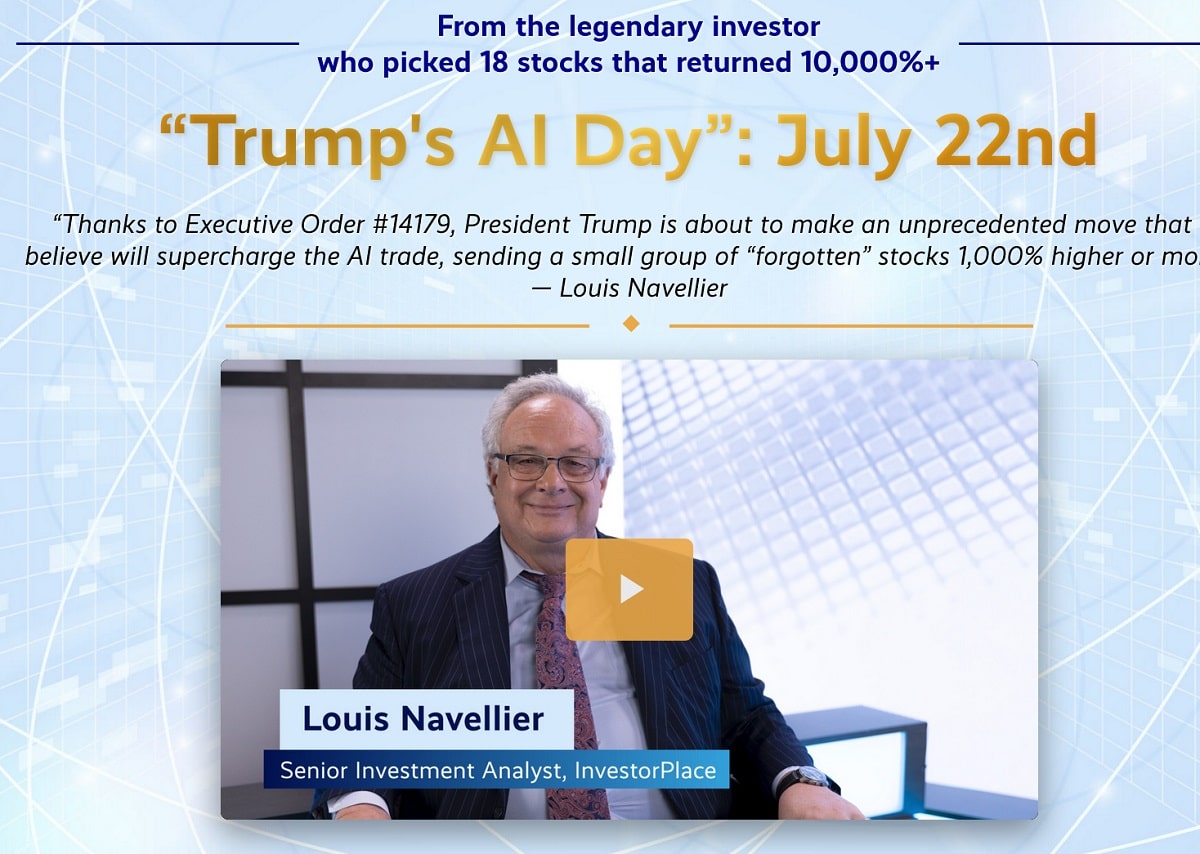On July 22, 2025, a pivotal moment in America’s technological and economic landscape is expected to unfold, dubbed “Trump’s AI Day” by legendary investor Louis Navellier. Anchored by Executive Order #14179, signed shortly after President Trump’s inauguration, this event is anticipated to mark a significant push to secure America’s leadership in artificial intelligence (AI).
Navellier, renowned for identifying 18 stocks that delivered 10,000%+ returns, argues that this executive action could ignite a historic boom in a lesser-known market subsector: critical minerals essential for AI infrastructure. Below, we delve into Navellier’s insights, exploring why these minerals—copper, cobalt, lithium, rare earths, and a lesser-known metal—are vital to AI’s future, how Trump’s policies could catalyze their growth, and why five specific stocks in Navellier’s Breakthrough Stocks portfolio may offer investors a rare opportunity before the July 22 deadline.
The Context of Trump’s AI Day
The year 2025 has been a turbulent one for global markets. In April, fears of a trade war triggered a $12 trillion wipeout in global stock values, with AI giants like Nvidia dropping 34%. Mainstream media outlets, including BlackRock’s CEO and the Daily Mail, warned of further crashes, with some predicting an 80% market collapse. Yet, Navellier accurately called the market bottom on April 8, anticipating Trump’s announcement of trade talks with over 75 countries, which spurred a nearly 10% market rebound. This foresight underscores his credibility as he now turns his attention to a transformative event: Trump’s AI Day.
Signed three days after Trump’s inauguration, Executive Order #14179 set a 180-day countdown, culminating on July 22, 2025, for federal agencies to develop a strategic plan to position America as the global AI leader. Navellier predicts this plan will include accelerated support for companies producing critical minerals—copper, cobalt, lithium, rare earths, and a specialized metal—essential for AI chips, data centers, and robotics. These minerals, often overlooked, form the backbone of AI infrastructure, and their limited supply, coupled with surging demand, creates what Navellier calls a “supply crunch” with explosive investment potential.
The Critical Role of Minerals in AI
AI’s rapid evolution—from language models like ChatGPT to physical applications like Elon Musk’s robotaxi network and Optimus humanoid robots—demands unprecedented computational power. This power relies on advanced chips, data centers, and robotics, all of which require specific minerals. Navellier highlights several key materials:
-
Copper: Essential for wiring, circuit boards, and data centers due to its unmatched electrical conductivity. With AI infrastructure investments projected at $300 billion in 2025 by companies like Microsoft and Amazon, copper demand is expected to create a 2.6 million-ton shortfall by 2030.
-
Cobalt and Lithium: Critical for lithium-ion batteries powering AI applications, including robotics and data centers. Past cobalt supply crunches, driven by electric vehicle (EV) demand, saw prices double in 2017.
-
Rare Earths (Neodymium, Praseodymium, Gallium): Used in AI chips, hard drives, and cooling systems due to their unique magnetic and electronic properties. China’s 70% control of U.S. rare earth supplies, coupled with recent export restrictions, heightens the urgency for domestic production.
-
A Specialized Metal: Described by Forbes as “The Most Important Mineral You Never Heard Of,” this metal is vital for low-voltage AI chips, data center efficiency, and military applications like missile systems and fighter jets. The U.S. imports 100% of this metal, primarily from China, which recently banned its export.
Navellier argues that these minerals are indispensable to AI’s growth, yet their supply is constrained, creating a classic supply-demand imbalance. Historical precedents, such as the internet-driven copper boom in the early 2000s and the EV-driven cobalt surge in 2016, demonstrate how such crunches can propel small-cap mineral stocks to extraordinary gains.
Historical Precedents for Mineral Booms
Navellier draws parallels between the current AI-driven mineral demand and past technological revolutions. In the early 2000s, the internet’s expansion fueled a copper boom, as broadband networks and data centers required extensive wiring. Stocks like Copper Fox Metals (1,100%), First Quantum Minerals (3,100%), and Lundin Mining (3,768%) soared, outpacing mainstream tech stocks like Amazon and Cisco. Similarly, the 2016 EV boom triggered a cobalt supply crunch, with stocks like Fuse Cobalt (1,000%), Canada Cobalt Works (2,000%), and Cruz Cobalt (5,000%) delivering massive returns in under two years. A 2010 rare earths crunch, driven by China’s export restrictions, saw Ucore Rare Metals, Lynas Rare Earths, and Rare Element Resources achieve gains up to 5,000%.
These examples illustrate the potential for small-cap mineral stocks to outperform during technological shifts. Navellier believes the AI revolution, combined with Trump’s policies, is setting the stage for a similar boom, with stocks trading for “pocket change” offering the greatest upside.
Trump’s Policy Push: The Permitting Council and Priority Status
A cornerstone of Navellier’s thesis is Trump’s proactive stance on securing domestic mineral supplies, driven by both economic and national security imperatives. Executive Order #14179 and related actions aim to reduce U.S. reliance on China, which controls 70% of rare earths and 100% of the specialized metal critical for AI and military applications. Trump’s Interior Secretary, Doug Burgum, has emphasized the need to “mine, baby, mine” to ensure America’s technological and economic dominance.
A key mechanism is the Permitting Council, a little-known federal agency tasked with fast-tracking permits for projects critical to national interests. Navellier identifies five companies likely to receive “priority status,” which streamlines regulatory processes and could include government funding. This support is crucial in mining, where permitting can take decades. Trump’s executive orders also promote deep-sea mining for rare earths and bolster domestic copper production, addressing the 45% of U.S. copper currently imported.
Navellier’s Breakthrough Stocks service, focused on small-cap opportunities, features a model portfolio with five mineral stocks poised to benefit from Trump’s AI Day. These include:
-
MP Materials (Ticker: MP): A vertically integrated rare earths company mining in California, positioned to reduce U.S. dependence on China. With a $5 billion market cap, it’s the largest of Navellier’s picks but still offers significant upside due to its strategic importance.
-
Deep-Sea Mining Company: Specializing in extracting polymetallic nodules rich in rare earths from the ocean floor, this company has applied for a commercial license under Trump’s deep-sea mining executive order. Its proprietary technology positions it as a leader in this emerging field.
-
Copper Mining Company: Owning the world’s largest undeveloped copper deposit, this company trades at approximately $1 per share. Its potential to address the projected 2.6 million-ton copper shortfall by 2030 makes it a prime candidate for fast-tracking.
-
Specialized Metal Company: The only U.S. company extracting and refining a critical metal used in AI chips and military applications. Operating in a “sold out” condition, it plans to expand with likely government support, given China’s export ban.
-
Rare Earths Developer: Owning one of America’s largest rare earth deposits, this company uses advanced technology to cut production timelines by five months. Currently under government review, it could secure $750 million in funding.
These companies, detailed in Navellier’s report The Critical Five: Five AI Mineral Stocks That Could Jump 1,000%, are selected for their low market caps and high growth potential, trading at prices Navellier compares to “a pack of gum.”

The Breakthrough Stocks Service
Navellier’s Breakthrough Stocks is designed for investors seeking high-growth small-cap opportunities. Priced at $1,799 for a one-year membership (a 55% discount from the $4,000 retail price), it includes:
-
Monthly Recommendations: 1–2 new small-cap picks, each with 1,000%+ potential.
-
The Critical Five Report: Details on the five mineral stocks.
-
Bonus Report 1: AI’s Crossover Moment: The 7 Must-Own Stocks for AI’s $100 Trillion Proliferation, focusing on physical AI applications like robotics.
-
Bonus Report 2: Nvidia’s Secret Weapon: The Small-Cap Poised to Kickstart the $46 Trillion Quantum Revolution, highlighting a company partnering with Nvidia on quantum AI.
-
Weekly Updates and Sell Alerts: Guidance on portfolio management.
-
Private Website Access: Training resources, podcasts, and the model portfolio.
The service is backed by a 90-day satisfaction guarantee, offering a full credit refund for other products, and a “Double Your Money” promise, ensuring five opportunities to double investments within 12 months or an additional year free.
Navellier’s credibility stems from his data-driven approach, honed as one of Wall Street’s first purely quantitative investors. His early adoption of computer-based trading systems led to 675 stocks doubling, 175 achieving 1,000%+ gains, and 18 reaching 10,000%+ at their peak.
His 2016 Nvidia recommendation, when it traded at $1 (split-adjusted), exemplifies his ability to spot undervalued stocks early. While past performance does not guarantee future results, and all investments carry risk, Navellier’s history underscores his expertise in identifying high-potential small-caps.
Risks and Considerations
Investing in small-cap mineral stocks involves significant risks. Market volatility, as seen in April 2025, can lead to sharp declines, and geopolitical factors, such as China’s export controls, add uncertainty. Regulatory delays, even with fast-tracking, could impact timelines, and mining projects face operational challenges. Investors must assess their risk tolerance and avoid allocating funds they cannot afford to lose. Navellier’s transparency, with performance details available on his disclosures page, allows for due diligence.
Why Act Before July 22?
Navellier emphasizes urgency due to the July 22 deadline, when Trump is expected to announce America’s AI strategy, potentially naming companies for priority status. Stocks like MP Materials and the deep-sea mining company could see immediate price surges if selected.
Waiting beyond this date risks missing the initial market reaction, as historical supply crunches show rapid price movements post-announcement.
Conclusion
Louis Navellier’s Breakthrough Stocks offers a compelling opportunity to capitalize on Trump’s AI Day through five small-cap mineral stocks critical to AI’s future. By targeting copper, rare earths, and a specialized metal, Navellier leverages a supply-demand imbalance exacerbated by Trump’s policies to reduce U.S. reliance on China. With a proven track record and a comprehensive service package, this strategy appeals to investors seeking high-growth opportunities in a volatile market. Acting before July 22, 2025, could position investors to benefit from a historic boom in a forgotten subsector.

































